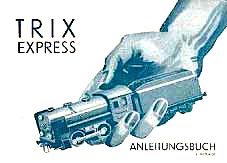Company Profile: Trix
History in a Nutshell
![]() Trix Modelleisenbahn GmbH & Co. KG was a venerable
German model manufacturer that began as two tin toy companies: one was founded in 1838 by Johann Haffner, the other in 1899 by Andreas Förtner. After Förtner
died in 1922, the two businesses merged to become Vereinigte Spielwarenfabriken (United Toy Company). In 1928, the company was taken over by
Stephan Bing, Herrmann Oppenheim and Siegfried Kahn,
who established a manufacturing facility in Nürnberg.
Trix Modelleisenbahn GmbH & Co. KG was a venerable
German model manufacturer that began as two tin toy companies: one was founded in 1838 by Johann Haffner, the other in 1899 by Andreas Förtner. After Förtner
died in 1922, the two businesses merged to become Vereinigte Spielwarenfabriken (United Toy Company). In 1928, the company was taken over by
Stephan Bing, Herrmann Oppenheim and Siegfried Kahn,
who established a manufacturing facility in Nürnberg.
 The Trix brand first appeared in 1931,
said to have been derived from the design of an early construction set, which had three rows of holes (referred to as Tri-X, and later just Trix).
Trix Express was presented to the public in 1935 at the
Leipziger Spring Fair; the 14-volt AC electric trains ran on three-rail 00 gauge (roughly HO) track mounted to a Bakelite base. United Toy subsequently
introduced the innovative Trix Twin system, which allowed two trains to be operated independently on the same track.
The Trix brand first appeared in 1931,
said to have been derived from the design of an early construction set, which had three rows of holes (referred to as Tri-X, and later just Trix).
Trix Express was presented to the public in 1935 at the
Leipziger Spring Fair; the 14-volt AC electric trains ran on three-rail 00 gauge (roughly HO) track mounted to a Bakelite base. United Toy subsequently
introduced the innovative Trix Twin system, which allowed two trains to be operated independently on the same track.
Trix's Jewish owners Bing and Kahn were victims of Aryanization after the Nürnberg Laws; consequently, they were forced to sell their share of the company in the early 1930s and emigrate to England. With the support of W.J. Bassett-Lowke, they began making English model trains under the name Trix Limited. Meanwhile, Ernst Voelk acquired United Toy Company in 1938. Until the beginning of the Second World War, the German and English companies shared close business ties, supplying one another with parts. As a result of the war, the toy industry in Germany came to a standstill, and by 1941, United's ability to continue toy production was in doubt as they began manufacturing precision mechanical and thermoelectric devices for the war effort. Because of the growing danger of Allied air raids, Trix relocated some of their manufacturing to a rural area in early 1943. Two years later, their original plant sustained heavy damage from bomb strikes, and many of their handmade patterns were destroyed.
It wasn't until 1948 when toy production could resume, and that Christmas saw a huge demand. Owing to their relocation effort, Trix was able to meet that demand, and their profits allowed them to rebuild their Nürnberg production facilities. By 1953 they'd begun making DC-powered trains, as had most of their competitors. They also collaborated with many of these companies, including Fleischmann, Kibri, Rivarossi, Roco and others. When Karl Arnold & Co launched their Rapido trains (not to be confused with Rapido Trains), Trix had already been competing with Lone Star's Treble-O-Trains push-along toys, and were developing electrically-powered N Scale trains of their own. Their Minitrix Electric line, introduced in 1964, was imported into the United States three years later by Aurora Plastics Corporation and sold under their Postage Stamp Trains brand.
![]() Beginning in 1970, Trix became the property of Mangold
GmbH & Company, an investment company. After Mangold went bankrupt in 1997, Trix was rescued by Märklin, at which point production
of all North American models was halted, possibly owing to an issue with tooling ownership. In 2009, Märklin filed for insolvency, got bought by the
Simba Dickie Group, and was renamed
Trix Trains.
Beginning in 1970, Trix became the property of Mangold
GmbH & Company, an investment company. After Mangold went bankrupt in 1997, Trix was rescued by Märklin, at which point production
of all North American models was halted, possibly owing to an issue with tooling ownership. In 2009, Märklin filed for insolvency, got bought by the
Simba Dickie Group, and was renamed
Trix Trains.
 Meanwhile, Trix Limited, the company founded by
Bing and Kahn in England, likewise changed hands a number of times. Renamed Trix Twin Railways, it struggled to survive because it had not changed from
3-rail to 2-rail track. The failing company was purchased in 1967 by the German Trix business, and became Trix Trains (not to be confused with the
current-day Trix Trains). Bankrupt by 1973, it then became the property of
Liliput, until 1993 when Liliput was bought by
Kader, owners of
Bachmann.
Meanwhile, Trix Limited, the company founded by
Bing and Kahn in England, likewise changed hands a number of times. Renamed Trix Twin Railways, it struggled to survive because it had not changed from
3-rail to 2-rail track. The failing company was purchased in 1967 by the German Trix business, and became Trix Trains (not to be confused with the
current-day Trix Trains). Bankrupt by 1973, it then became the property of
Liliput, until 1993 when Liliput was bought by
Kader, owners of
Bachmann.
N Scale Products
Minitrix products practically need no introduction; they're known globally thanks to importers such as Aurora. Trix's first N Scale locomotive, known in America as the "Little Donkey," was in production for nearly thirty years.

Printed Matter
- Minitrix Catalog ca. 1960
- 1964 Trix Catalog
- 1965 Trix Catalog
- 1966 Minitrix Leaflet
- 1968 Minitrix Catalog
